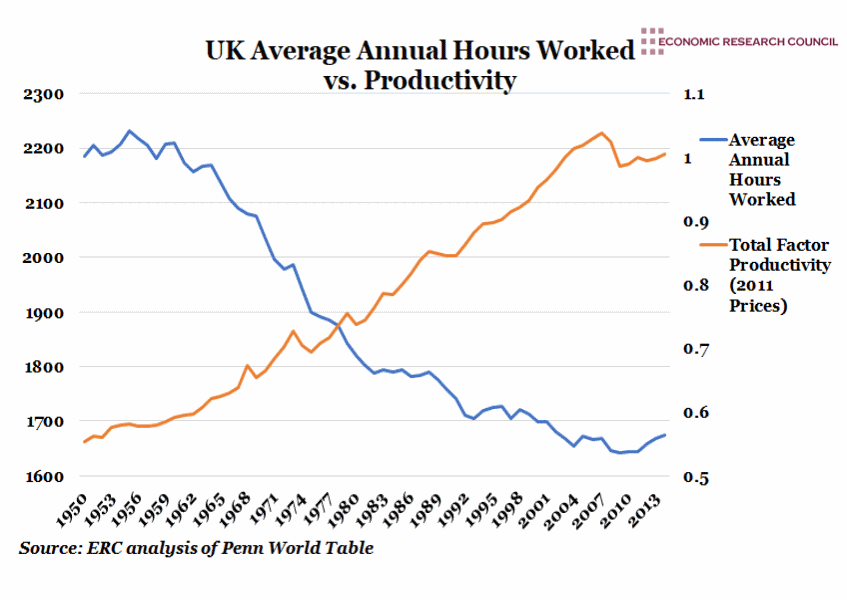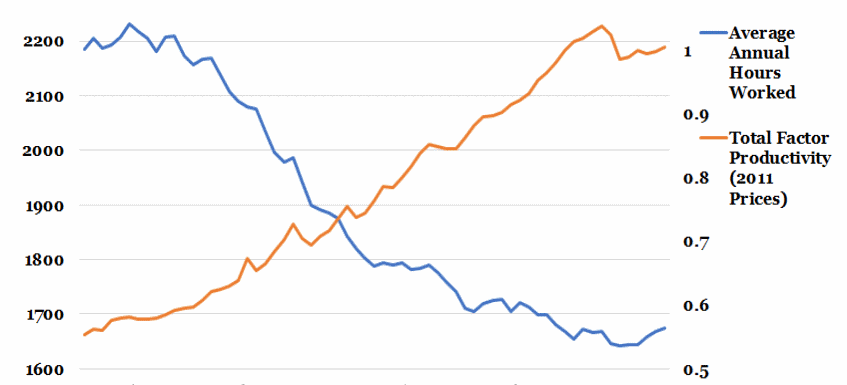
Summary
In 1930 Keynes predicted that in 100 years, developed nations would be able to achieve a 15-hour average work week due to productivity increases. Currently, many workers’ hours far exceed this, especially those in low -income and -human capital sectors. However, given productivity advancements over the past half-century, there remains continuing engagement with the ideas alternative to the traditional 40-hour work week. Recent studies have shown that workers not only experience increased well-being, but are also more productive when working fewer hours via increases in both the number and duration of breaks during the work day.
What does the chart show?
This chart plots average annual hours worked vs. productivity in the UK. Average annual hours worked is a per-worker measure, graphed by the blue line and reported on the left-hand axis. Across many nations, average hours worked per week have declined from around 40 to just above 30 between 1950 and 2014. The orange line, measured against the right hand axis, reflects Total Factor Productivity, a measure of productivity which accounts for labour, capital and technological change. This makes TFP a ‘multi-factor’ measure. In its most basic form, total factor productivity is a measure of productivity which shows the proportion of output not explained by either the size of the workforce the size of a nation’s capital stock (e.g. machine tools). A nation can have a high population and a high capital stock, yet at the same time can have low output due to low total factor productivity, or the realised output it gets from its inputs of labour and capital.
Why is the chart interesting?
According to labour market theory, when workers experience real wage stagnation or decreases, as with the UK story, they increase their leisure intake and reduce work hours as a result of a substitution effect. This effect arises because the relative price of leisure (or the real wage) has decreased, so workers will consume more of it. Conversely, if real wages decrease, workers will have an income effect driving them to maintain their pre-existing standard of living. Thus, they will increase their working hours. It is often unclear which effect outweighs the other, but if this chart is to be of any indication, the periods of decrease amidst wage stagnation point to a more prevalent substitution effect. However, recent years in the wake of the financial crisis show that perhaps the income effect has rebounded for most workers, resulting in an increase in average hours since 2010.
More studies are shedding light on worker behaviour in terms of their hours and productivity. In November 2018, Perpetual Guardian, a New Zealand-based financial services company with a staff of 240, implemented a new opt-in labour experiment for their workers. Those who opted in were given one additional paid day off per five-day work week. They were also asked to deliver the same amount of output as in a standard week. This study is very much grounded in behavioral economics. As stated by the Head of People and Capability at Perpetual Guardian, ‘if employees are engaged with their job and employer, they are more productive. The trial was a valuable and timely way to test our theory that efficiencies will come with more staff focus and motivation’. This departs from what is shown in the chart, as the productivity gains expressed in total factor productivity are heavily subject to endogeneity. It is difficult to pinpoint any one factor as causing the whole effect. As no new productivity-increasing technology was introduced during the trial period at Perpetual Guardian, the study can illuminate the effect of increased worker engagement in isolation. The only variable altered was the extra work day although management did engage with the staff to devise and ensure plans to maintain or improve their productivity.
Overall, the results were positive. When surveyed, employees who worked for 30 hours yet were paid for 37.5 hours reported increases in many measures of wellbeing when compared to a 2017 survey of Perpetual Guardian workers. The number of employees who reported positive work-life balance rose from 54% to 78%. Staff who reported work-related stress decreased from 45% to 38%. Importantly, work engagement increasing with measures of ‘commitment’ up by 20%, ‘stimulation’ up by 18%, and ‘empowerment’ by 20%. Output stayed the same among those who were granted an extra day off, meaning that these workers were more productive per-hour during the four-day week than they had been during the previous 37.5-hour week. Qualifying these results however, initial excitement about the program resulted in larger than average productivity increases for a short time period after the study began. After the excitement waned, productivity growth regressed slightly, yet remained higher than as measured in the counterfactual 2017 scenario. According to a manager at Perpetual Guardian, to ensure that employees did not become complacent, they ‘spent a lot of time making sure every person in every team [had] their own plan as to…maintain, and even improve, their productivity.”
Congruent studies on a smaller scale have shown similar results. Embracing work breaks: Recovering from work stress, conducted by Fritz et al, found that employees who took dedicated breaks during work hours reported less stress, higher productivity and spillover effects such as improved sleeping habits. These results are intuitive. A UK study of 2,000 full time office workers found that the average employee spent two hours and 53 minutes working a day. Social media, news, personal calls and messages and socialising were reported to have significant negative effects on productive hours during the day. Yet, 54% of those surveyed said the distractions made the working day ‘more bearable.’
Time constraints and uncertainty around wider applicability are potential problems with studies such as the one conducted at Perpetual Guardian. Since the 4-day program was only implemented in November 2018, there is no way to tell if a longer time horizon would have resulted in growing complacency and thus lower productivity than was observed over the 3 months. Additionally, this study and others like it which examine workers in offices may not be applicable to other sectors, such as retail and manufacturing, which rely on direct worker presence and engagement with customers. Indeed many of these customers are themselves shopping on their own days off from work. Essentially, this could create an effect where less work time for participants in one sector could result in an increased work requirement for members of the consumer service sector.
Lastly, it is questionable how applicable this study is to relatively new, non-traditional work environments such as in the gig economy. Many non-traditional workers can work upwards of 50 or 60 hours a week, often in areas which require them to engage directly with other people. Indeed this poses problems for the data for average annual work hours as presented in the chart. Gig economy workers often undertake workloads which are subject to a large degree of variation in both duration and remuneration, a product of increased worker agency.
Week 8, 2019

